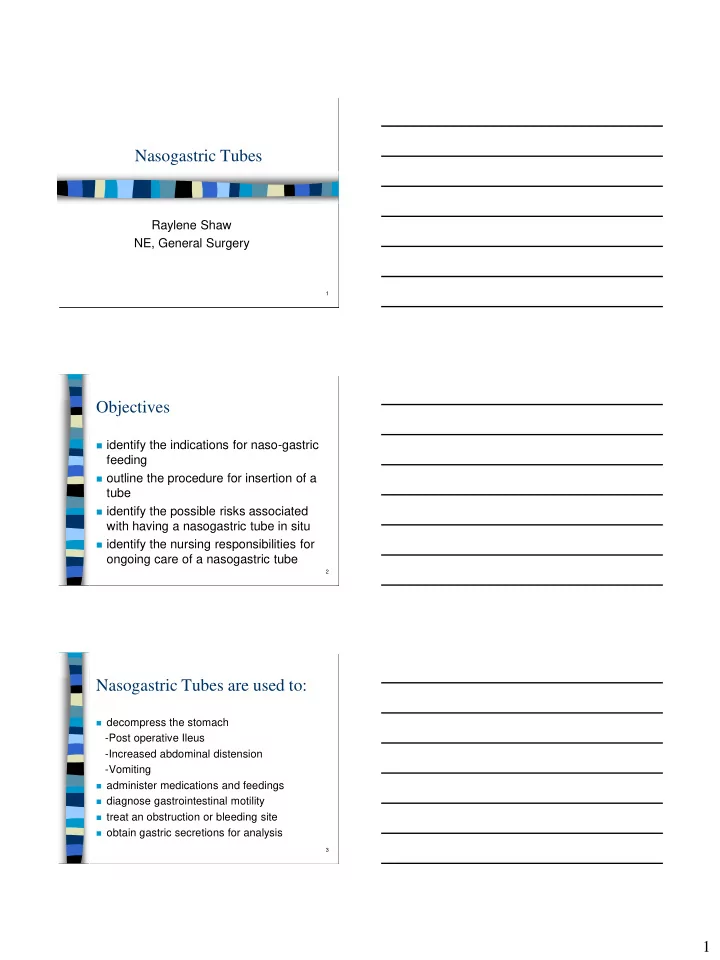

Nasogastric Tubes Raylene Shaw NE, General Surgery 1 Objectives identify the indications for naso-gastric feeding outline the procedure for insertion of a tube identify the possible risks associated with having a nasogastric tube in situ identify the nursing responsibilities for ongoing care of a nasogastric tube 2 Nasogastric Tubes are used to: decompress the stomach -Post operative Ileus -Increased abdominal distension -Vomiting administer medications and feedings diagnose gastrointestinal motility treat an obstruction or bleeding site obtain gastric secretions for analysis 3 1
Contra indications Reduced level of consciousness Fractured skull Maxillo-facial trauma/disorders or surgery Disorders of the naso pharynx and/or oesophagus 4 Choice of tube Roche Ryles tubes are most commonly used for removal of fluid and gas – single lumen - plastic – wide bore, stiff/firm tube – Tube size from 8-18Fr but 14-16Fr usually used – Not recommended for enteral feeding > week as increased complications (Rhinitis/Oesophagitis, and Gastritis 5 Fine bore Feeding tubes for feeding/administering medications (Flexiflo/Flocare/Corflo) – single lumen - polyurethane/silicone – small bore, soft/flexible (tungsten tip/stylet) – usually size 8 – 10 (12 or less) These can provide short term access (for up to 6 weeks) 6 2
Equipment required What equipment do we need to undertake inserting a Naso-gastric tube? 7 Preparation Anaesthetic spray (must be charted and signed for) Check patency of nostrils to ascertain no obstruction liable to prevent easy insertion – ask about previous nasal injuries/surgery – ask patient to sniff with one nostril closed/blocked - repeat with other nostril 8 measure length of tube for insertion – tip of nose earlobe 5 cms past xiphoid process 9 3
Procedure (cont) DON”T force tube insert tube as far as marked/identified length observe for coughing/respiratory distress – indicates tube has passed into trachea and may be in the bronchus 10 Check position of tube establishment of correct position essential – intrapulmonary feeding or aspiration check patient’s mouth – tube may be curled up at back of mouth aspirate stomach contents - test pH – gastric aspirate is acidic - approx 5.5 – pH levels may be altered by certain meds- antacids, H2 receptor blocking agents e.g. ranitidine, famotidine 11 Troubleshooting if aspirate cannot be obtained – inject approx 30mls of air - try again – reposition patient onto left side , wait 30 minutes , try again if all the above not conclusive, there are doubts regarding the placement or if pH indicator is unclear - X-ray to confirm placement 12 4
Completion of procedure secure tube change tape at least every 48 hours – to ensure tube secure and for patient comfort spiggot or attach a drainage bag – bag below level of stomach complete procedure – equipment disposal etc 13 Document What size tube used Which nostril How was placement confirmed? Complications Care plan (orders re aspiration/spiggoting/)feeding Fluid balance chart Signed for Local anaesthetic spray 14 Enteral feeding Confirm orders from enteral feeding form Meticulous hand hygiene at all times when dealing with feeds Aseptic non-touch technique when connecting system to feeding tube Ensure the correct storage of feeds Carefully check manufacturers instructions on how to access feed (don’t break foil seal with scissors) Bottles should have time feed started recorded on them Lines should be dated and when due for change 15 5
Enteral feeding Ensure dieticians orders have been checked regarding how long feeds can hang for Pre-packaged feeds should be discontinued after 24hours Non pre packaged feeds usually discontinued after 6 hours Do not re use single use containers and giving sets Enteral feeds are delivered using a specific enteral feeding pump Enteral feeds must be entered on Fluid balance chart 16 Drug Administration Consult Pharmacist re Medications when your patient has a naso-gastric tube insitu. Need to consider – what formulation to use – any interaction with the feed – possible blockage of tube 17 Blocked Tubes and Flushing All tubes require regular flushing to prevent blockage flushing should be performed before and after medication and at least four hourly – at least 50mls of water (check with paediatric patients) 18 6
Syringe Size should be between 30 - 50 ml smaller syringes produce high pressure – may damage/rupture tube 19 Care of patient patient should be nursed with head raised at least 30 – to prevent gastric reflux regular nasal and oral hygiene Position should be checked daily (check permanent pen mark) 20 Tube position must be checked using pH indicator strips before anything is administered Tube position must be checked using pH indicator strips prior to commencing enteral feeds Check tube position if patient has had an episode of vomiting/coughing or possibility of tube dislodgment Tube must be flushed before and after anything is administered Documentation of all fluids on fluid balance 21 7
Tubes other that Naso gastric Post pyloric tubes inserted under radiological guidance Can increase level of absorption and decrease vomiting Do not aspirate 22 Removal of naso gastric tube Determine type of tube Verify order for removal Ensure that the patient is in an upright position with head supported with pillows Aspirate gastric contents then Flush with 10-20 mls air Remove securing device 23 Instruct patient to take a deep breath and hold (this will close off the glottis reducing risk of potential aspiration ) While removing , pinch off the tubing (this will prevent any contents draining into the patient’s throat) 24 8
Recommend
More recommend